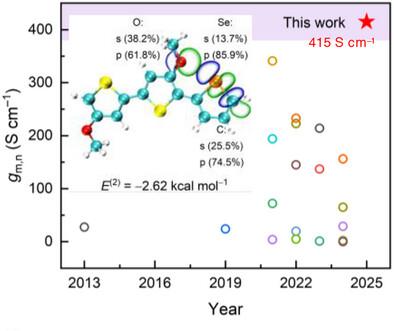High Iontronic Performance in Organic Electrochemical Transistors Enabled by Intramolecular Noncovalent Interactions
IF 26.8
1区 材料科学
Q1 CHEMISTRY, MULTIDISCIPLINARY
引用次数: 0
Abstract
Organic electrochemical transistors (OECTs) show great potential in bioelectronics due to their iontronic coupling, low driving voltages (<1 V), and biocompatibility. Nevertheless, their low iontronic performance, particularly in terms of transconductance (gm), limits their ability to acquire high-precision biosignals. To address this issue, a series of poly(bithiophene)s (opg2T-O, opg2T-S, and opg2T-Se) bearing 4,4′-position glycol side chains are synthesized. Upon varying furan, thiophene, and selenophene comonomers, the intramolecular noncovalent interactions are systematically tuned. Comprehensive theoretical analyses reveal that opg2T-Se demonstrates stronger intramolecular Se···O noncovalent interactions than the S···O interactions in opg2T-S and opg2T-O, affording a more planar and rigid molecular configuration in opg2T-Se. Meanwhile, opg2T-Se exhibits closer π–π stacking and lamellar-packing and prefers an edge-on orientation. Consequently, a record-high geometry-normalized transconductance (gm,n) of 415 S cm−1, along with remarkable hole mobility (µ = 2.99 cm2 V−1 s−1) and volumetric capacitance (C* = 423.3 F cm−3) are achieved in opg2T-Se based OECTs. Importantly, the opg2T-Se-based devices exhibits much higher signal fidelity in in-vitro human electrocardiogram (ECG) than the other two devices. This study highlights the importance of intramolecular noncovalent interaction in the channel layer materials for achieving high-performance OECTs.

分子内非共价相互作用使有机电化学晶体管具有高离子电子性能
有机电化学晶体管(OECTs)由于其离子电子耦合、低驱动电压(< 1v)和生物相容性而在生物电子学领域显示出巨大的潜力。然而,它们的低离子电子性能,特别是在跨导(gm)方面,限制了它们获取高精度生物信号的能力。为了解决这个问题,合成了一系列含4,4 '位乙二醇侧链的聚(二噻吩)s (opg2T-O, opg2T-S和opg2T-Se)。根据呋喃、噻吩和硒烯共聚物的不同,分子内非共价相互作用被系统地调整。综合理论分析表明,opg2T-Se分子内Se··O非共价相互作用比opg2T-S和opg2T-O中的S··O相互作用更强,使opg2T-Se具有更平面和刚性的分子构型。同时,opg2T-Se表现出更紧密的π -π堆积和层状堆积,倾向于边对边取向。因此,在基于opg2T-Se的oect中,实现了创纪录的415 S cm−1的几何归一化跨电导(gm,n),以及显著的空穴迁移率(µ= 2.99 cm2 V−1 S−1)和体积电容(C* = 423.3 F cm−3)。重要的是,基于opg2t - se的设备在体外人体心电图(ECG)中表现出比其他两种设备更高的信号保真度。这项研究强调了通道层材料中分子内非共价相互作用对实现高性能OECTs的重要性。
本文章由计算机程序翻译,如有差异,请以英文原文为准。
求助全文
约1分钟内获得全文
求助全文
来源期刊

Advanced Materials
工程技术-材料科学:综合
CiteScore
43.00
自引率
4.10%
发文量
2182
审稿时长
2 months
期刊介绍:
Advanced Materials, one of the world's most prestigious journals and the foundation of the Advanced portfolio, is the home of choice for best-in-class materials science for more than 30 years. Following this fast-growing and interdisciplinary field, we are considering and publishing the most important discoveries on any and all materials from materials scientists, chemists, physicists, engineers as well as health and life scientists and bringing you the latest results and trends in modern materials-related research every week.
 求助内容:
求助内容: 应助结果提醒方式:
应助结果提醒方式:


